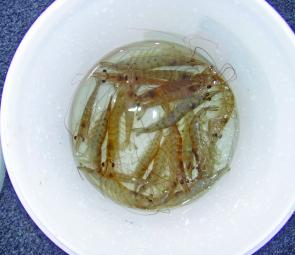It’s that time of year again and the prawns are back. There are always a few of them up the creeks and the best ones to hit are Ningi Creek, Elimbah Creek and Glass House Creek.
Prawning has got to be one of the best ways to spend the day with the family out on the water, despite getting a bit dirty. Get out on the boat and head up the creeks chasing prawns for a feed is fun for everyone.
The simple way to catch prawns is with a cast net but you can also get them by drag netting. You can buy a cast net from any bait and tackle store.
When buying a cast net make sure you have the right size cast net for the size of your body. For instance, if you’re a big sort of person you don’t want some little tiny cast net, you want one that’s reasonably big that you can throw properly.
Likewise, buy a cast net with top and bottom pockets. This is because when you cast the net in the water the prawns flick up and down in the net and the pockets are excellent for catching these strays.
There are many different ways and styles of cast netting. I know that Jaret, Dad and myself all throw the net different to one another because we all have our own styles and techniques of throwing. The best way to learn how to throw a cast net is by getting someone to teach you, that way you can learn and practise. There are also lots of DVDs and books out there to help perfect your technique. Once you’ve learnt how to throw a net, it’s time to go out and hopefully catch some prawns.
When prawning, it’s always a good idea to plan your trip before you go. The best time to catch prawns is on the low tide, because the prawns are not in amongst the mangroves, so plan to go one hour before the low and leave an hour after the low.
As you travel up the creek towards your desired spot, keep an eye on the back of the boat for wayward prawns. Quite often, the wash from the boat scares the prawns and they jump behind it, meaning you might not have to go as far up the creek as you think.
Once you have found your patch of prawns, get your net ready and throw it into the water where the prawns are. Let the net sink all the way to the bottom to ensure no prawns can get out the bottom of the net. Once the net is completely on the bottom, slowly drag it towards you so that the bottom of the net drags close on the bottom of the creek. When the net is finally closed at the bottom you can lift it into the boat to see what you have.
When cast netting you can catch lots of other things besides prawns, such as fish and crabs. However, there are lots of other things you have to be careful of and watch out for as well, such as stonefish and stingrays. When cleaning your net out beware of these species masquerading as clumps of mud as you don’t want to be stung by a stonefish or tangle with the spines of a stingray.
Like most angling outings, it’s always a good idea to take someone with you in case something happens. Also it makes prawning a whole lot easier when you can both take in turns at driving the boat. This is because the driver can position the boat in exactly the right place to throw your net, and they can then reverse away to ensure the bottom of the net closes.
The main prawns to catch around the local area are greasy prawns or school prawns but when cast netting you can get other prawns amongst them like banana prawns, tiger prawns and leader prawns. Hopefully this can help you with your cast netting and you can go out there and catch a feed of prawns for yourself.
Reads: 44494
Prawning has got to be one of the best ways to spend the day with the family out on the water.




